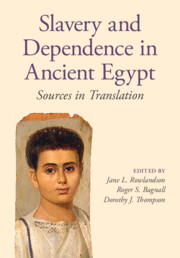Book contents
- Frontmatter
- Contents
- List of illustrations
- List of maps
- List of contributors
- Biographical notice on Jane Rowlandson
- Preface
- List of abbreviations
- Note to the reader
- Aids for the reader
- Glossary of technical terms
- 1 Introduction
- 2 Pharaonic Egypt
- 3 The Late Period
- 4 Jewish perspectives on slavery in Egypt
- 5 Ptolemaic Egypt
- 6 Roman Egypt
- 7 Byzantine and Umayyad Egypt
- Concordance of texts
- Bibliography
- Index
2 - Pharaonic Egypt
Published online by Cambridge University Press: 01 March 2024
- Frontmatter
- Contents
- List of illustrations
- List of maps
- List of contributors
- Biographical notice on Jane Rowlandson
- Preface
- List of abbreviations
- Note to the reader
- Aids for the reader
- Glossary of technical terms
- 1 Introduction
- 2 Pharaonic Egypt
- 3 The Late Period
- 4 Jewish perspectives on slavery in Egypt
- 5 Ptolemaic Egypt
- 6 Roman Egypt
- 7 Byzantine and Umayyad Egypt
- Concordance of texts
- Bibliography
- Index
Summary
In this chapter tomb paintings join the selection of texts (preserved on stone, papyrus, and leather) to show the role of dependence as a structural feature of pharaonic society. Foreigners were acquired through raiding and warfare, and settled in both existing and new communities. An actual trade in persons is also documented and varying aspects of the experience of such individuals is examined, as they were exploited by those who purchased them or passed them on as gifts. Changes over time in the vocabulary of dependence are discussed, as are the different types of work and production in which such dependents were involved. Non-free dependents were employed on the land, in animal herding, and in artisanal workshops, especially textiles, as well as in the home. The key economic role of Egyptian temples is a constant feature of the period.
- Type
- Chapter
- Information
- Slavery and Dependence in Ancient EgyptSources in Translation, pp. 37 - 118Publisher: Cambridge University PressPrint publication year: 2024

